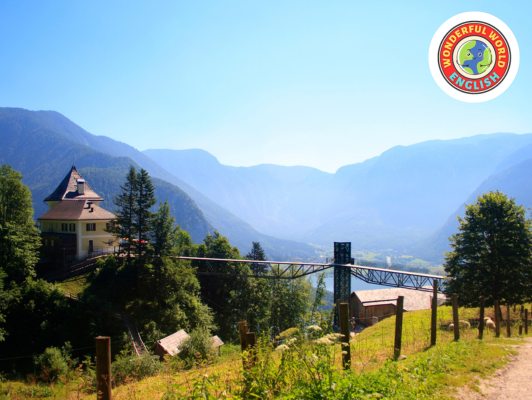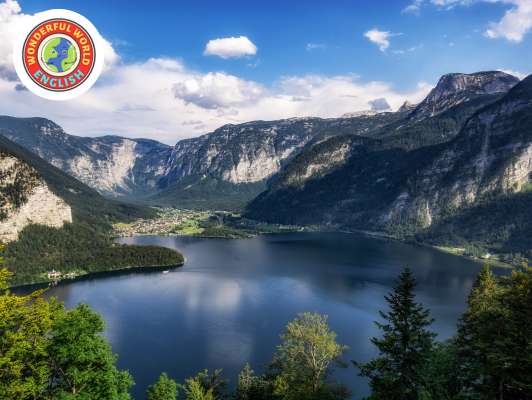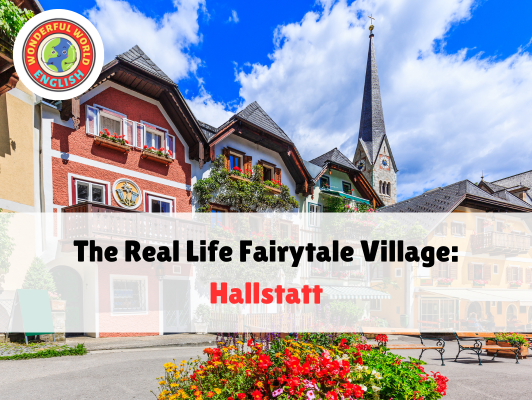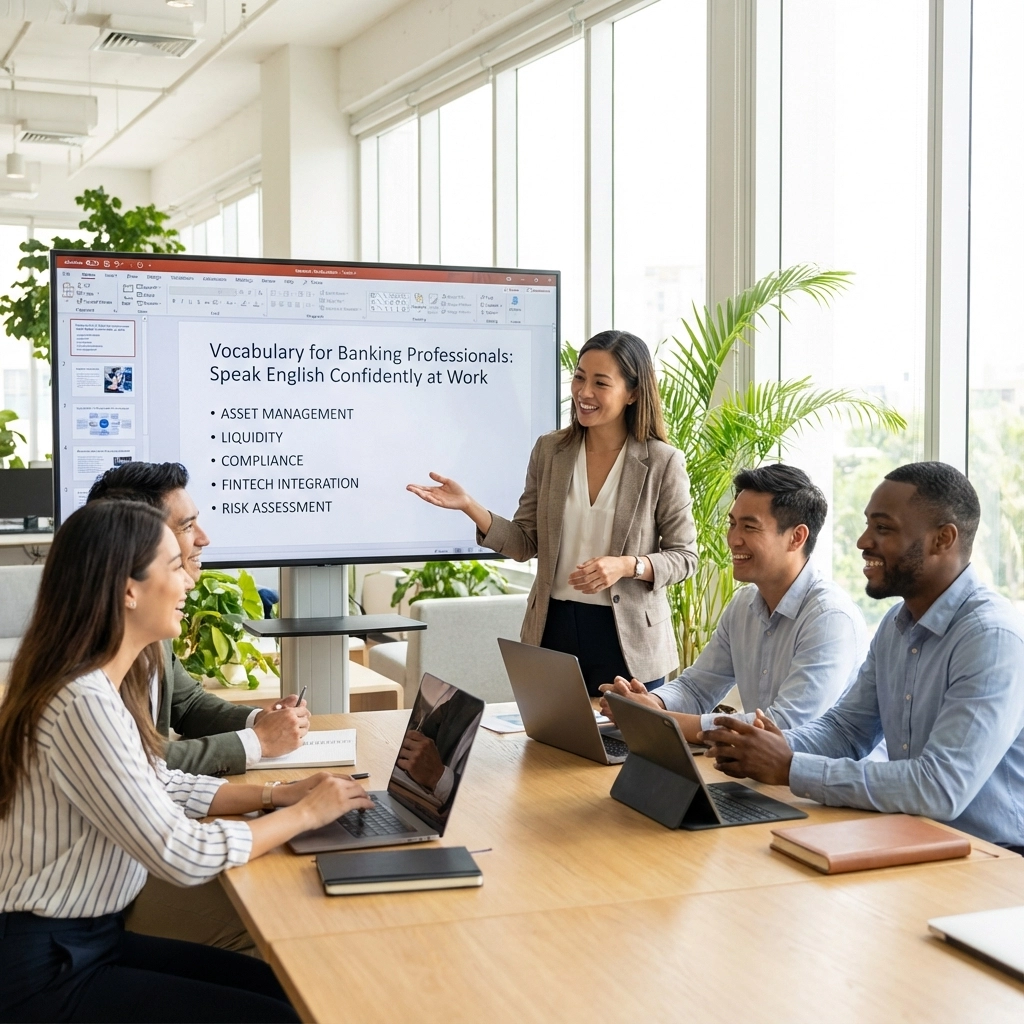Contents
Toggle
Meet David De’ Ath, founder, editor, and writer at Wonderful World English. With his extensive background as an English teacher, David provides valuable insights and practical tips on ESL for students and teachers alike.
Nestled in the heart of Austria, Hallstatt is a picturesque village that captures the charm of nature and history.
It’s renowned for its stunning landscapes, including the serene Lake Hallstatt and towering Dachstein mountains.
Visitors are greeted by charming Alpine houses, winding streets, and a peaceful atmosphere that makes it feel like stepping into a postcard.
Hallstatt also has a rich history, dating back thousands of years to its roots as a salt mining hub.
Today, you can explore ancient salt mines and even an ossuary, known as the Beinhaus, which holds intricately decorated human skulls.
These historical layers add depth to the beauty of this enchanting place.
With a mix of natural beauty and fascinating history, Hallstatt offers something for everyone.
Whether you’re into relaxing by the lake, hiking the mountain trails, or discovering centuries-old secrets, this village promises a memorable and enriching experience.
Geography and Climate
Hallstatt is a small town known for its stunning landscapes and unique weather patterns.
Located by a serene lake and surrounded by mountains, this town has a mix of features that make it special.
Location and Topography
Hallstatt is situated in Upper Austria, nestled between the Hallstätter See (Lake Hallstatt) and the Dachstein mountains.
Its coordinates are approximately 47.5614° N latitude and 13.6493° E longitude.
The town is in the Salzkammergut region, a UNESCO World Heritage site.
The Hallstätter See adds to the beauty, providing a peaceful waterfront.
Mountains around Hallstatt are mostly part of the Dachstein range.
These create a stunning backdrop and offer opportunities for hiking and skiing.
Even though it’s a small area, the diverse elevations make the topography interesting.
Caves like the Dachstein Ice Cave add to the unique features.
Weather Patterns
Hallstatt experiences a temperate climate.
Summers are mild, with average temperatures around 20°C to 25°C (68°F to 77°F).
Winters are cold but not extreme, usually staying between -1°C to 4°C (30°F to 39°F).
Rain is quite common throughout the year.
The lake and surrounding mountains contribute to frequent fog and mist, adding to the mystical feel of the area.
Snowfall occurs primarily from December to February, making it a picturesque winter destination.
The varied weather makes it essential to check forecasts if planning outdoor activities.
Overall, Hallstatt’s climate complements its scenic beauty, making it a year-round attraction for visitors.

Cultural Significance
Hallstatt stands as a shining example of ancient beauty and cultural depth.
Its legacy is preserved through UNESCO recognition, its charming architecture, and age-old traditions that continue to thrive.
UNESCO World Heritage Status
Hallstatt was designated a UNESCO World Heritage Site in 1997.
This recognition highlights its historical and cultural importance.
The town dates back to prehistoric times, making it one of the oldest still-inhabited settlements in Europe.
The salt mines, also part of this heritage status, play a significant role.
These mines are among the oldest in the world, and their history reaches back over 7,000 years.
This makes Hallstatt a place of immense historical importance.
Architectural Highlights
Hallstatt’s architecture is both charming and functional.
The houses are built close together, clinging to the mountainside.
This gives the town a very unique and picturesque appearance.
Wooden buildings with slanted roofs characterize the local building style, offering added charm.
The main square is a focal point, often bustling with both locals and tourists.
It is surrounded by beautifully preserved houses and public buildings, each telling its own story.
The local church, with its tall and slender bell tower, stands out against the backdrop of the mountains and lake.
Local Traditions
Local traditions in Hallstatt are deeply rooted in its history and surroundings.
Salt mining has been the cornerstone of life here for thousands of years.
This long-standing tradition is celebrated annually with various local festivals.
Another notable tradition is the craft of woodworking, which has been passed down through generations.
From wooden toys to intricate carvings, these crafts are a significant part of local culture.
During the year, seasonal festivals bring the community together and allow visitors to experience Hallstatt’s rich cultural fabric firsthand.
These events are opportunities for people to connect, celebrate, and keep traditions alive.

Economy and Industry
Hallstatt’s economy revolves around salt mining, tourism, and its rich tradition of craftsmanship.
Salt Mining History
Hallstatt’s salt mining history dates back over 7,000 years.
The town is one of the oldest locations where salt has been mined.
The presence of salt deposits has brought wealth and influenced the culture.
Salt was sometimes referred to as “white gold” due to its high value. Mining operations expanded under Roman rule.
Modern mining started in the 16th century. Hallstatt became well-known for its efficient mining techniques.
Exploring the ancient salt mines is a popular tourist activity.
The tunnels and mining equipment offer a glimpse into the past.
Today, salt mining still contributes to the local economy but to a lesser extent than before.
Tourism and Hospitality
Tourism forms a major part of Hallstatt’s economy.
The scenic views of Hallstätter See lake and alpine backdrop attract visitors from all over the world.
Guided tours are available to explore historical sites and the salt mines.
The town offers a variety of accommodations from hotels to charming guesthouses.
Visitors can enjoy alpine hiking, boat trips, and cultural events.
The town’s small size makes it easy to explore on foot.
Hallstatt has a well-established hospitality industry. The local restaurants serve regional dishes, often featuring fish from the lake. Souvenir shops offer unique handmade items.
Tourism provides vital jobs for many residents.
Craftsmanship and Trade
Craftsmanship has deep roots in Hallstatt.
Traditional skills have been passed down through generations.
Woodworking and pottery are notable crafts in the town.
Handcrafted items often feature unique designs inspired by the local landscape.
Local artisans are known for their quality and precision.
Many workshops are open to visitors, who can see artisans at work and purchase handmade goods.
Trade also plays a role in Hallstatt’s economy.
Farmers’ markets offer local produce, cheese, and meats.
Small businesses benefit from both locals and tourists.
Craftsmanship and trade contribute significantly to the town’s charm and economic sustainability.

Visitor Information
Hallstatt offers a unique blend of natural beauty, historical attractions, and delightful local cuisine.
This guide covers essential travel tips, must-see attractions, and local food experiences.
Travel and Accommodation
Hallstatt can be reached by car, bus, or train.
For those arriving by car, parking on the outskirts is recommended because the town has narrow streets.
Public transportation includes buses that connect to nearby towns and Hallstatt train station across the lake, with a ferry service to the town center.
Accommodation ranges from cozy guesthouses to luxurious hotels.
Popular choices include Heritage Hotel and Seewirt Zauner for their stunning lake views and central locations.
Booking in advance is advised, especially during peak tourist seasons.
Must-See Attractions
One of the most iconic spots is the Hallstatt Skywalk, offering panoramic views.
It’s accessible via a funicular railway.
The ancient Salt Mine is another key attraction, showcasing the town’s mining history.
Hallstatt’s Market Square is great for those interested in picturesque architecture and small boutiques.
Nature enthusiasts should not miss Lake Hallstatt and its scenic boat rides.
Visitors can also enjoy hiking trails around the lake and mountains.
Culinary Experience
Hallstatt features a variety of foods that reflect its rich cultural history.
Traditional Austrian dishes like Wiener Schnitzel and Apfelstrudel are found in many local restaurants.
Gasthof Zauner is well-loved for its authentic Austrian menu.
For seafood lovers, dishes made with fish from Lake Hallstatt are a must-try.
Café Derbl offers delightful pastries and coffee, perfect for an afternoon break.
Don’t forget to try local wines and beers to complete your culinary adventure.
We hope you find value in this information; you can contact us if you are in need of any assistance.
Have a wonderful day!
Image Attribution: All images licensed via canva.com





